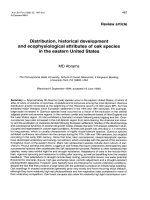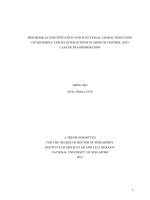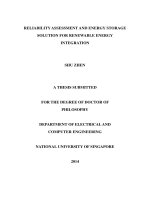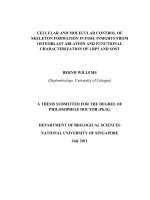Critical control points involving calcium hypochlorite and storage temperatures for microbial safety and physico-chemical attributes of oysters (Crassostrea gasar)
Bạn đang xem bản rút gọn của tài liệu. Xem và tải ngay bản đầy đủ của tài liệu tại đây (918.54 KB, 14 trang )
Int.J.Curr.Microbiol.App.Sci (2020) 9(3): 3028-3047
International Journal of Current Microbiology and Applied Sciences
ISSN: 2319-7706 Volume 9 Number 3 (2020)
Journal homepage:
Original Research Article
/>
Critical Control Points Involving Calcium Hypochlorite and Storage
Temperatures for Microbial Safety and Physico-Chemical Attributes
of Oysters (Crassostrea gasar)
Bernard J.O. Efiuvwevwere*, Chimezie J. Ogugbue, Godwin Emoghene
and Augustine K. Ngbara-ue
Department of Microbiology, Faculty of Science, University of Port Harcourt,
Port Harcourt, Nigeria
*Corresponding author
ABSTRACT
Keywords
Oysters, critical
control points,
HACCP, microbial
safety, calcium
hypochlorite
Article Info
Accepted:
25 February 2020
Available Online:
10 March 2020
Oysters (Crassostrea gasar) are globally important but highly susceptible to microbial
hazards. Critical control points (CCPs) for oyster safety involving 10 ppm calcium
hypochlorite Ca(OCl)2, storage temperatures and traditional postharvest practices were
employed. Microbiological and physico-chemical characteristics were analyzed. Un-iced
storage (27-35oC) resulted in significant total viable counts (TVCs) exceeding
recommended limits (approx. 5 log10 cfu/g). Diverse microbial profiles and hazardous
levels occurred in traditionally handled samples compared to Ca(OCl) 2 treated samples.
Regardless of Ca(OCl)2 application, significant microbial populations (5.28 log10 cfu/g
and 6.43 log10 cfu/g) and undesirable pH (<6.30) and trimethylamine contents of 37.65 and
45.84 mgN/100g were occasioned by 27-35oC storage. The preponderance of pathogenic
Gram positive organisms (Bacillus and Staphylococcus spp.) occurred in 27-350C stored
samples irrespective of Ca(OCl)2 application. A remarkable increase in Gram positive flora
to Gram negative profile ratio of approximately 5-fold occurred in 4-60C stored samples
versus 27-350C stored samples; underscoring the impacts of storage temperature. These
clearly demonstrate the critical role of storage temperature in spite of other CCPs
employed. Overall, the need for adoption of CCPs has been demonstrated indicating that
cold-chain practice is necessary to enhance microbial safety of oyster and maximize its
local and international trade.
Introduction
Oysters (Crassostrea gasar) are of
considerable economic importance and
nutritional value globally (Galaviz- Villa et
al., 2015; Jay, 2000). However, they are often
exposed to a wide range of microorganisms in
the aquatic ecosystem thereby accumulating
several different microbiota since they are
filter-feeders (Galaviz-Villa et al., 2015;
Depaola et al., 2010; APHA, 2001).
Consequently, their levels of microbial
contamination are usually very high and
sometimes constitute public health hazards to
consumers (Ozbay et al., 2018; Jay,2000).
Whereas there is abundance of oysters in the
3028
Int.J.Curr.Microbiol.App.Sci (2020) 9(3): 3028-3047
Niger Delta region of Nigeria, the high levels
of microbial hazards associated with them
constitute a major concern. In addition, the
potential of oysters and other seafoods to
harbour microbial pathogens and eventually
cause food-borne diseases is well documented
for both developed and developing countries
(Jonnalagadda et al., 2009; Yonnes and
Bartram, 2001). However, oysters remain
acceptable if unshucked but they lose quality
rapidly once shucked except preserved (Chen
et al., 2016; Efiuvwevwere and Amadi,
2015).
Materials and Methods
Collection of oyster samples
Freshly harvested oysters (Crassostrea gasar)
from Andoni River, Rivers State, Nigeria
were purchased from seafood harvesters
based on prior arrangements. They were then
transported to the laboratory in two
polystyrene boxes (one containing ice packs
and the other, no ice) within 4hr of harvest for
analyses.
Processing and treatment of oysters
Hazard analysis critical control point
(HACCP) has become a global systematic
approach to ensuring food safety and
wholesomeness as well as enhancement of
international food trade (Galaviz-Villa et al.,
2015; WHO, 2007). Additionally, the benefits
of HACCP to the seafood industry have been
underscored by several workers elsewhere
(National Seafood HACCP Alliance, 2017;
Jonnalagadda etal; 2009; Rahman, 2007).
Therefore, the production of safe and high
quality oysters in Nigeria and other countries
for both domestic and export trade using
HACCP concept is of critical economic
importance and public health significance
(Feltes et al., 2017; Montanhini and Neto,
2015). Unfortunately, in spite of such benefits
associated with HACCP application globally,
very little or no research work on oysters to
establish any critical control points or
measures concerning microbial safety to
consumers is available in Nigeria.
However, HACCP-related work on children’s
foods was carried out by Ehiri et al.,
(2001).Thus, the present investigation was
undertaken to focus on the application of
HACCP using various parameters (such as
calcium hypochlorite) to serve as critical
control points or measures during processing
in relation to microbial profiles and safety of
oysters.
The oyster samples (approx. 5kg) were sorted
into comparable sizes (approx.10g each) and
divided into two portions. One portion was
kept in a polystyrene box layered with
polythene bag and packed with ice blocks (460C) while the other portion was kept in a
polystyrene box without ice blocks. Both
boxes were transported to the laboratory and
on arrival, the samples were individually
cleaned/washed thoroughly and shucked
manually aseptically or as traditionally
practised.
Following
the
CCPs/treatments,
microbiological
and
physico-chemical
characteristics were analyzed.
Microbiological analysis
A composite (25g) of shucked oyster samples
was blended in 225 ml 0.1% (w/v) peptone
water using a stomacher (model BA 6021,
Seward Medical, London, UK) to obtain 10-1
dilution. Further 10-fold dilutions were
prepared and spread-plated (0.1ml aliquot) in
triplicate on surface-dried plate count agar,
MacConkey agar, Mannitol salt agar,
Thiosulphite-citrate-bile-sucrose agar and
Salmonella-Shigella agar and incubated at
370C for 18-24hr.
3029
Int.J.Curr.Microbiol.App.Sci (2020) 9(3): 3028-3047
The plates were then examined for growth of
colonies and enumeration of total viable
counts, coliforms, Staphylococcus spp.,
Vibrio spp. and Salmonella spp. counts was
carried out. All the culture media used were
products of Titan Biotech. Ltd., India.
Identification of bacterial isolates
Typical
representative
colonies
were
randomly picked from plates showing 25-250
colonies, purified, characterized using
motility, Gram reaction, spore stain, catalase,
coagulase, urease, citrate utilization, indole
production, Methyl-Red (MR), VogesProskauer and sugar fermentation tests (triple
sugar iron agar, glucose, sucrose, lactose and
mannitol) and subsequently identified based
on colonial, cellular and biochemical
characteristics (APHA, 2001; Cheesbrough,
2000; Sneath et al., 1986).
Chemical analysis: pH and trimethylamine
(TMA)
The pH of composite (10g) oyster samples of
the respectively treated samples were
determined after blending in 20ml distilled
water (1:2 ratio) (Efiuvwevwere and Amadi,
2015) using a calibrated pH meter (model
Jenco 6177, USA).
The TMA contents of the respective triplicate
samples were determined as described by
Malle and Poumeyrol (1989). The
determination involved use of Kjedahl
distillation unit 2100 (Foss, Sweden).
Statistical analysis
The data generated for different quality
characteristics were analysed using Analysis
of variance (ANOVA) software of SPSS
version 15 and the significance of the mean
differences determined at p<0.05.
Results and Discussion
Microbial quality of oyster samples as
influenced by critical control points
The populations of the various microbial
groups differed significantly with critical
control points (CCPs) as shown in Table 1.
The highest total viable counts (TVCs) of
6.73 log10 cfu/g and 6.43 log10 cfu/g were
observed in un-iced oyster samples on arrival
in the laboratory (i.e about 4 hr following
harvest) and those immersed in tap water
before ambient temperature storage for 48hr
respectively (Table 1).
In contrast, samples subjected to other CCPs
exhibited lowest significant counts with those
immersed in 10 ppm calcium hypochlorite
alone as well as those subjected to 10 ppm
calcium hypochlorite prior to refrigerated
storage for 48hr (Table 1). Similarly, the
lowest coliform counts were 1.49 log10 cfu/g
and 1.41 cfu/g involving oyster subjected to
10 ppm calcium hypochlorite treatment alone
and those immersed in 10 ppm calcium
hypochlorite then followed by refrigerated
storage for 48hr (Table 1). Comparable trends
as observed in TVCs and coliform counts
were also found in Staphylococcus spp counts
(Table 1).
However, some variations with respect to
effects of CCPs on Salmonella spp and Vibrio
spp counts were observed (Table 1).
Evidently, these microbial population
variations reflect the impacts of CCPs in
oyster processing which confirm that certain
conditions or treatments favour the
development or growth of microorganisms
and at the same time, inhibit the development
or growth of others. These are termed the
intrinsic, processing and extrinsic factors
(1CMSF 1980; Gould, 1989; Banwart, 2004)
and they play critical roles in microbial food
safety and spoilage.
3030
Int.J.Curr.Microbiol.App.Sci (2020) 9(3): 3028-3047
For example, refrigeration temperature is
critical for control of growth and activity of
microorganisms hence the lower the
temperature, the lower the microbial
population (Banwart, 2004) as evidenced in
this work (Table 1). However, most
mesophilic microorganisms do not grow
below 100C.
Consequently, they are not often a problem in
refrigerated foods but some mesophiles are
psychrotrophic in nature and are capable of
growth in refrigerated foods (Banwart, 2004).
Thus, the critical control measures concerning
microbial safety of oysters should be applied
in conjunction with refrigeration temperature.
Additionally, the National Shellfish Sanitation
Program (Banwart, 2004) established a
microbiological criterion of total viable
counts for shellfish (including oysters)
ranging between 4.70 and 6.0 log10 cfu/g.
Evidently, 4 out of the 9 treatments of the
samples subjected to CCPs viz, (a) un-iced
oysters, (b) iced oysters, (c) iced, immersed in
tap water and stored at ambient temperature
for 48hr as well as (d) those immersed in 10
ppm calcium hypochlorite before storage for
48hr at ambient temperature (Table 1) are
unacceptable since samples subjected to those
treatments had TVCs which exceeded the
recommended limit of 4.>0 log cfu/g to 6.0
log10 cfu/g (Banwart, 2004).
The antibacterial benefits exhibited by
samples subjected to CCPs involving calcium
hypochlorite treatment may be attributed to
the formation of hypochlorous acid and
disruption of several vital functions of the
microorganisms (Dumani et
al.,
2016; Wikipedia: />ki/calcium_hypochlorite). But the high
populations of Salmonella spp. and Vibrio
spp. especially in samples stored at ambient
temperature (Table 1) clearly indicate the
potential microbial hazards of these samples
to consumers being good sources for
transmission of these pathogens (Jay, 2000).
Furthermore, these microorganisms have been
reported to increase to hazardous numbers
when exposed to high temperatures (Miget
2010). Therefore, the need for implementation
of cold- chain food supply to reduce the risks
of microbial growth has been demonstrated as
evidenced by the present results (Table 1).
Microorganisms isolated from oyster
samples as influenced by critical control
points and storage temperatures
Several bacterial genera were isolated from
the oyster samples and they varied with the
critical control points (Table 2). The most
diverse bacterial genera (6) occurred in
virtually all the samples (un-iced, iced,
cleaned/washed and shucked, iced and
immersed in tap water (control) and those
subjected to 10 ppm calcium hypochlorite
before refrigeration (4-60C) storage for 48hr
(Table 2).
In contrast, only 4 bacterial genera were
isolated from shucked oysters immersed in 10
ppm calcium hypochlorite (as CCP) (Table 2).
Nonetheless, irrespective of the CCP applied,
Bacillus spp. occurred in all treatments (Table
2). Thus, these results corroborate the
ubiquitous nature of Bacillus spp. including
their
psychrotrophic,
mesophilic
and
thermophilic characteristics coupled with
variations in pH of their growth ranging from
acidic to alkaline with most growing at pH
6.5-7.5 (Banwart, 2004) which is comparable
to the pH values of the oyster samples.
The relative low population and frequency of
occurrence of Staphylococcus spp. in samples
treated with calcium hypochlorite (Tables 1
and 2) suggest their sensitivity to chlorine
compounds as previously reported (Dumani et
al., 2016; Banwart, 2004).
3031
Int.J.Curr.Microbiol.App.Sci (2020) 9(3): 3028-3047
pH and TMA contents
The effects of critical control points (CCPs)
on pH of oysters are shown in Table 3.
Limited pH variations were observed with the
highest (7.07) occurring in samples immersed
in 10 ppm calcium hypochlorite and
refrigerated for 48hr and those immersed in
tap water before refrigeration storage for 48hr
(pH 6.95) while the lowest (pH 6.25) occurred
in un-iced and shucked as well as those
immersed in tap water prior to ambient
temperature storage for 48hr (pH 6.21) (Table
3).
The marginal variations in pH associated with
the CCPs/treatments are similar to the
findings by others (Mudoh et al., 2014; Cao et
al., 2009) which showed slight decreases in
pH of oysters stored under different low
temperatures. Oysters contain relatively high
carbohydrate content (Cao e tal. 2009) hence
prone to fermentative process (Jay, 2000).
Therefore, decrease in its pH is deemed to be
an indication of on-set of spoilage. Thus, the
samples having pH values of 6.30 and below
(Table 3) are considered to be in the process
of spoilage and are generally unacceptable
(Cao et al., 2009).
The TMA contents varied with CCPs
resulting in maximum contents (45.84mg
N/100g) in samples immersed in tap water
and stored at ambient temperature for 48hr
followed with those immersed in 10 ppm
calcium
hypochlorite
before
ambient
temperature storage for 48hr (37.65mg
N/100g) (Table 3).
In contrast, the lowest contents (1.28mg
N/100g) occurred in samples immersed in 10
ppm calcium hypochlorite only or those
immersed in 10 ppm calcium hypochlorite
and stored at refrigeration temperature for
48hr (Table 3).
TMA is a good indicator of seafood
(including oyster) freshness or spoilage
(Efiuvwevwere and Amadi, 2015; Cao et al.,
2009). The higher the value, the lower the
quality. It is evident from the results (Table 3)
that samples subjected to 10 ppm calcium
hypochlorite or immersed in tap water prior to
ambient temperature storage were spoiled
having exceeded the TMA limit of
acceptability (10-15mgN/100g)
which
apparently must have been exacerbated by
the high ambient temperature (Oruwari and
Efiuvwevwere 2016; Jay, 2000).
Correlation
coefficients
of
parameters
and
their
Table 4 shows the correlation values for the
several correlated variables. The pH either
correlated poorly or negatively against the
microbial groups but showed strong negative
correlation (r=-7185) between pH and
Staphylococcus spp. counts (Table 4). On the
other hand, TMA content correlated
positively (r=0.5221) against Salmonella spp.
counts. Significantly positive correlation (r=
0.9909) was observed between total viable
counts and coliform counts (Table 4).
Similarly, microbial groups showed strong
correlations such as TVCs against Vibrio spp.
(r=0.9861) and coliforms vs Vibrio (r=
0.9772) (Table 4).
These variations in correlations between
variables clearly indicate the impacts of
interplay among parameters such as the
effects of calcium hypochlorite and storage
temperatures on some of the microbial
groups. Thus, their growth behaviour became
altered and could not be closely correlated as
would have been the case. Consequently, the
use of such microbial group to predict the
growth/behaviour of another group became
complex and highly unpredictable as was
reported earlier (Edberg and Smith, 1989).
3032
Int.J.Curr.Microbiol.App.Sci (2020) 9(3): 3028-3047
Percentage frequency of occurrence of
bacteria isolated from oyster samples as
influenced by critical control points
(CCPs)/treatments
and
storage
temperatures
Figures 2a and 2b show the percentage
frequency of bacteria isolated from un-iced
and iced oyster samples respectively.
Whereas
Bacillus
spp.
(26%)
and
Staphylococcus spp. (22%) dominated the uniced samples, Pseudomonas spp. (15%) and
Vibrio spp. (21%) were the most dominant
microorganisms in the iced samples (Figure
2b).
This differential in microbial prevalence may
be attributed to impact of bacterial growth
temperatures which corroborate some earlier
findings which indicated that Bacillus spp.
mostly exhibit both psychrotrophic and
mesophilic growth characteristics (Ozbay et
al., 2018; Chen et al., 2016; Montanhini and
Neto, 2015; Banwart, 2004). In contrast,
Pseudomonas spp and Vibrio spp are
predominantly psychrophilic /pschrotrophic in
nature and this partly explains their
prevalence in the iced-stored samples (Figure
2b).
The dominance of the cleaned/washed and
shucked samples by Bacillus spp (34%) and
Staphylococcus spp (30%) (Figure 3) clearly
indicates their ability to survive and thrive in
more adverse conditions since they are Gram
positive organisms and moreso, Bacillus spp
are aerobic, wide-spread in nature and sporeformers (Jay, 2000).
On the contrary, only four bacterial genera
dominated by Bacillus spp. (65%) and
Staphylococcus spp. (24%) occurred in
shucked oysters subjected to 10 ppm calcium
hypochlorite only (Figure 4a). This further
confirms the survival of Gram positive flora
and spore-formers in unfavourable conditions
(Figure 4a). This also confirms that calcium
hypochlorite is an inhibitory agent to
microbial growth (Dumani et al., 2016). On
the other hand, samples subjected to tap water
as control showed most diverse bacterial
profile consisting of six bacterial genera
dominated by both Gram positive and Gram
negative flora (Figure 4b).
The effect of pH is likely to have played a
role because of the pH intrinsic property of
oyster (Mudoh et al., 2014; Jay, 2000). Figure
5a shows the percentage frequency of
occurrence of bacteria isolated from oysters
subjected to CCPs involving application of
10 ppm calcium hypochlorite before
refrigeration storage for 48hr. The high
prevalence of Pseudomonas spp (40%) could
be attributed to the favourable low
temperature of growth associated with these
microorganisms as psychrophiles (Chen et al.,
2016; Jay, 2000).
Similarly, the immersion of the samples in tap
water (control) also resulted in Pseudomonas
spp. (43%)
being the most dominant
organism under refrigeration storage (Figure
5a).
This further corroborates the impact of
refrigeration temperature on growth of
Pseudomonas spp. regardless of additional
control measures. However, when the samples
were subjected to 10 ppm calcium
hypochlorite prior to ambient temperature
storage for 48hr as critical control point,
Bacillus spp drastically increased to 51% and
followed by Staphylococcus spp (19%)
(Figure 6a).
Thus, the commercial/traditional practice of
immersing oysters in tap water before
ambient temperature storage exacerbated the
bacterial profile thereby increasing the
dominance of Staphylococcus spp to 41% and
enhanced the microbial hazards as well as
potential risks to consumers.
3033
Int.J.Curr.Microbiol.App.Sci (2020) 9(3): 3028-3047
Table.1 Total viable counts, coliforms, Staphylococcus spp; Salmonella spp. and Vibrio spp. counts (log10cfu/g) of oyster samples as
influenced by critical control points (CCPs)/ treatments and storage temperatures Microbiological quality (log10cfu/g)
Samples/CCPs/Treatments
Uniced oysters
Iced oysters
Iced + cleaned/washed + shucked
Iced + 10ppm Ca(OCl)2
Iced+ tap water (control)
Iced + tap water+48hr Refrigeration temperature
Iced + 10 ppm Ca(OCl)2 +48hr Refrigeration temperature
Iced+tap water +48hr Ambient temperature storage
Iced + Ca (OCL)2 + 48hr Ambient temperature storage
TVCs
6.73a
5.56b
3.95c
2.59f
3.53d
3.45d
2.93e
6.43a
5.28b
Coliforms
5.07b
4.61c
2.23e
1.40g
1.74f
2.30e
1.41g
5.55a
4.00d
Staphylococcus
4.54a
4.37b
1.99e
1.16g
1.51f
2.06d
1.42f
4.10b
3.76c
Salmonella
4.83a
4.51b
2.54e
2.12f
2.72e
3.35d
1.43g
4.98a
4.00c
Vibrio
4.57C
4.20d
2.38g
2.04h
2.88f
3.18e
2.84f
5.80a
5.09b
Ca(OCl)2 = Calcium hypochlorite; Values (means) of triplicate determinations in columns under different microbial groups having different letters are
significantly (p<0.05) different.
Table.2 Microorganisms isolated from oyster samples as influenced by critical control points (CCPs)/treatments and storage temperatures
Samples/CCPs/Treatments
Un-iced fresh oysters
Iced fresh oysters
Iced fresh oysters +cleaned/washed +shucked
Fresh shucked oysters + 10 ppm Ca(OCl)2
Fresh shucked oysters + tap water (control)
Fresh shucked oysters + 10 ppm Ca(OCl)2+ 48hr Ref.
Fresh shucked oysters + tap water +48hr Ref.
Fresh shucked oysters + 10 ppm Ca(OCl)2 + 48hr Amb.
Fresh shucked oysters + tap water + 48hr Amb.
Microorganisms Isolated
Bacillus spp., E. coli, Pseudomonas spp., Salmonella spp, Staphylococcus spp, Vibrio spp.
Bacillus spp
E. coli
Pseudomonas spp., Salmonella spp, Staphylococcus spp, Vibrio spp
Bacillus spp., E. coli, Pseudomonas spp, Salmonella spp, Staphylococcus spp, Vibrio spp.
Bacillus spp., E.coli, Salmonella spp, Staphylococcus spp
Bacillus spp.,E.coli, Proteus spp, Salmonella spp, Staphylococcus spp, Vibrio spp.
Bacillus spp., E.coli, Pseudomonas spp, Salmonella spp, Staphylococcus spp, Vibrio spp.
Bacillus spp., E.coli, Proteus spp, Pseudomonas spp, Salmonella spp, Vibrio spp.
Bacillus spp., E. coli, Salmonella spp, Staphylococcus spp, Vibrio spp.
Bacillus spp., E.coli, Salmonella spp, Staphylococcus spp, Vibrio spp.
Ca(OCl)2 = Calcium hypochlorite, Ref = Refrigeration storage; Amb. = Ambient temperature storage
3034
Int.J.Curr.Microbiol.App.Sci (2020) 9(3): 3028-3047
Table.3 pH and Trimethylamine (TMA) contents of oyster samples as influenced by critical
control points (CCPs)/treatments and storage temperature
Samples/CCPs/Treatments
Un-iced fresh oysters
Iced fresh oysters
Iced + cleaned/washed + shucked oysters
Fresh shucked oysters + 10 ppm Ca(OCl)2
Fresh shucked oysters + tap water (control)
Fresh shucked oysters + 10 ppm Ca(OCl)2 + 48hr Ref.
Fresh shucked oysters + tap water + 48hr Ref.
Fresh shucked oysters + 10 ppm Ca(OCl)2 + 48hr Amb.
Fresh shucked oysters + tap water + 48hr Amb.
pH
6.25e
6.30e
6.28e
6.56d
6.60d
7.07a
6.95b
6.83c
6.21e
TMA(mgN/100g)
3.30c
3.64d
3.23e
1.28f
3.42e
1.06f
4.34c
37.65b
45.84a
Ca(OCl)2 = Calcium hypochlorite; Ref. = Refrigeration temperature; Amb. = Ambient temperature storage. Mean values
of triplicate determinations in columns of pH and TMA having different letters are significantly (p<0.05) different
Table.4 Correlation between physico-chemical parameters (pH and TMA), microbial groups
and among the microbial groups in oyster samples as influenced by critical control points
(CCPs)/treatments
Correlated variables
pH versus TMA
pH versus Total viable counts (TVCs)
pH versus coliforms
pH versus Staphylococcus spp counts
pH versus Salmonella spp counts
pH versus Vibrio spp counts
TMA versus TVCs
TMA versus coliform counts
TMA versus Staphylococcus spp counts
TMA versus Salmonella spp counts
TMA versus Vibrio spp counts
TVCs versus coliform counts
TVCs versus Staphylococcus spp counts
TVCs versus Salmonella spp counts
TVCs versus Vibrio spp counts
Coliform counts versus Staphylococcus spp count
Coliform counts versus Salmonella spp count
Coliform counts versus Vibrio spp counts
Staphylococcus spp count versus Salmonella spp counts
Staphylococcus spp counts versus Vibrio spp counts
Correlation values (r*, r**)
0.4552
-0.4693
-0.4701
-0.7185**
0.2198
-0.3704
-0.3463
-0.3493
-0.2630
0.5221*
-0.2990
0.9909**
0.1635
-0.1770
0.9861**
0.1742
-0.1710
0.9772**
-0.1227
0.0353
Correlation values (r* and r** = 0.01 and 0.001 level of significance respectively). Correlation coefficients are based on
overall mean of 9 determinations of 3 replicates (n=27)
3035
Int.J.Curr.Microbiol.App.Sci (2020) 9(3): 3028-3047
Figure.1 The critical control points (CCPs) used during the processing of oysters
Figure.2a Percentage frequency of occurrence of bacteria isolated from un-iced oyster samples
3036
Int.J.Curr.Microbiol.App.Sci (2020) 9(3): 3028-3047
Figure.2b Percentage frequency of occurrence of bacteria isolated from iced oyster samples
Figure.3 Percentage frequency of occurrence of bacteria isolated from iced, cleaned/washed and
shucked oyster samples
Figure.4a Percentage frequency of occurrence of bacteria isolated from iced, shucked oyster
samples immersed in 10 ppm calcium hypochlorite
3037
Int.J.Curr.Microbiol.App.Sci (2020) 9(3): 3028-3047
Figure.4b Percentage frequency of occurrence of bacteria isolated from iced, shucked oyster
samples immersed in tap water (control)
Figure.5a Percentage frequency of occurrence of bacteria isolated from iced, shucked oyster
samples immersed in 10 ppm calcium hypochlorite prior to refrigerated storage for 48 hr
Figure.5b Percentage frequency of occurrence of bacteria isolated from iced, shucked oyster
samples immersed in tap water prior to refrigerated storage for 48hr
3038
Int.J.Curr.Microbiol.App.Sci (2020) 9(3): 3028-3047
Figure.6a Percentage frequency of occurrence of bacteria isolated from iced,
shucked oyster samples immersed in 10 ppm calcium hypochlorite prior to ambient
temperature storage for 48 hr
Figure.6b Percentage frequency of occurrence of bacteria isolated from iced, shucked oyster
samples immersed in tap water prior to ambient temperature storage for 48 hr.
It is therefore evident that irrespective of the
CCPs (such as application of calcium
hypochlorite), the impacts of temperature of
storage appears to override those of some
other critical control measures particularly
when the effects of refrigeration storage are
compared with the ambient temperature
storage. These effects are underscored when
the Gram positive bacteria isolated from
refrigerated samples are compared with
ambient temperature stored samples. For
example, Figure 5a versus Figure 6a clearly
illustrates the shift in bacterial profile from
ratio of Gram positive to Gram negative flora
with 31:69 (i.e 0.45) versus 70:30 (i.e 2.33).
Thus, this clearly shows the dramatic increase
of approximately 5-fold in Gram positive
organisms which may be attributed to effect
of microbial growth temperature.
The microbiological safety of oysters has
been shown to be enhanced by application of
critical control points involving use of
calcium hypochlorite in conjunction with
3039
Int.J.Curr.Microbiol.App.Sci (2020) 9(3): 3028-3047
refrigeration storage (4-6°C). Transportation
of oysters following harvest in an un-iced
polythene box adversely resulted in
significant microbial population increase.
Irrespective of transportation of oysters in
iced box and application of calcium
hypochlorite, storage at ambient temperature
of 27°C-35°C led to significantly high
microbial
populations
exceeding
recommended population of approximately
5log10 cfu/g with concomitant undesirable
physico-chemical parameters (pH and TMA).
Whereas strong positive correlations were
observed in some parameters, others showed
negative or poor relationships. Thus, they
could not be used as indicators for prediction
and this may be attributed to the application
of critical control points. Overall, whereas
critical control points are important in
processing of oysters (including other foods),
adequate consideration should be given to
combination of CCPs application with
temperature of storage being a major impact
factor.
Acknowledgements
The Lead Researcher of the team, Bernard
J.O. Efiuvwevwere expresses his gratitude to
the Tertiary Education Trust Fund (TetFund)
for providing the research grant for this
research project (Ref:Tetfund/DESS/UNI/PHarcourt/ibr/2016/Vol.1).
References
APHA (2001).Compendium of methods for
the microbiological examination of
foods. 4th ed. Washington DC:
American Public Health Association.
Banwart,
G.J.
(2004).
Basic
Food
Microbiology.2ndEdn. Chapman & Hall
Inc. New York.
Cheesbrough, M. (2000).District Laboratory
Practice in Tropical countries part
2.Cambridge University Press.
Chen, H; Liu, Z; Shi, Y. and Ding, H.H.
(2016). Microbiological analysis and
microbiota in oyster: a review.
Information Systems J. 13:374-388.
Depaola, A; Jones, J.L., Woods, J., Burkhardt,
W., Calci, K.R., Krantz, J.A., Bewers,
J.C., Kasturi, K; Byars, R.H; Jacobs, E;
Williams-Hill, D. and Nabe, K. (2010).
Bacterial and viral pathogens in live
oysters: 2007 United States Market
Survey. Appl. Environ. Microbiol.
76(9): 2754-2768.
Dumwni, A; Guvenmez, H.K., Yilmaz, S.,
Yoldas, O. and Kurklu, Z. G. B. (2016).
Antibacterial efficacy of calcium
hypochlorite with vibringe sonic
irrigation system on Enterococcus
faecalis: An in-vitro study. Biomed.
Res. Int. Vol. 2016, Article ID 8076131.
Edberg, S.C. and Smith, D.B. (1989).Absence
of
association
between
total
heterotrophic and total coliform bacteria
from a public water supply. Appl.
Environ. Microbiol. 55:380-384.
Efiuvwevwere, B.J.O. and Amadi, L.O.
(2015) Effects of preservatives on the
bacteriological chemical and sensory
qualities
of
mangrove
oyster
(Crassostrea gasar). British J. Appl.
Sci. Technol. 5(1): 76-84.
Ehiri, J.E; Azubuike, M.C; Ubbaonu, C.N;
Anyanwu, E.C; Ibe, K.M and Ogbonna,
M.Q, (2001). Critical control points of
complementary food preparation and
handling in eastern Nigeria. Bull World
Health Org. 79(5): 423-433.
Feltes, M.M.C; Arisseto-Bragotto, A.P. and
Block, J.M. (2017).Food quality, foodborne diseases, and food safety in the
Brazilian food industry.Food Quality
and Safety, 1:13-27.
Galaviz-Villa,
I;
Lango-Reynoso,
F;
Castaneda-Charez, Ma.del.R; RomeroGonzalez, L., Amaro-Espejo, L.A and
Zuniga- Ruiz, P. (2015). Risks and
3040
Int.J.Curr.Microbiol.App.Sci (2020) 9(3): 3028-3047
critical points of the oyster product
system. Global J. Biol. Agric Health
Sci. 4(2): 25-32.
Jay, J.M. (2000). Modern Food Microbiology,
6thedn. Chapman Hall, New York.
Jonnalagadda, P.R., Sudershan, R.V; Raji,
N.S.
and
Rao,
D.R.
(2009).
Identification of critical control points
in the two selected HACCP-certified
prawn processing units, J. Food Quality
32:177-189.
Malle, P. and Poumeyrol, M.A. (1989).New
Chemical criterion for determination of
trimethylamine and total volatile base
nitrogen. J. Food Protect. 52:419-423.
Miget, R. (2010). Shellfish handling
practices-shrimp and molluscs.Southern
Regional Aquaculture Center. (SRAC),
Publication No. 4902.
Montanhini, M.T. M. and Neto, R.M.
(2015).Changes in the microbiological
quality
of
mangrove
oysters
(Crassostrea
bacsiliana)
during
different storage conditions. J. Food
Protect. 78(1): 164-171.
Mudoh, M.F., Par Veen, S. Schwarz, J.,
Rippen, T. and Chandhuri, A.
(2014).The
effects
of
storage
temperature on the growth of Vibrio
parahaemolyticus and organoleptic
properties in oysters. Frontiers in Public
Health 2:1-7.
National Seafood HACCP Alliance (2017).
Commercial
processing
example:
shucked oysters. National seafood
HACCP Alliance for Training and
Education. pp 1-13.
Oruwari, B.O. and Efiuvwevwere, B.J.O.
(2016).The effects of different storage
temperatures
on
the
microbial,
physicochemical
and
organoleptic
quality changes in the shellfish “Ngolo”
(Thais califera) from Nigeria. British
Microbiol. Res. J. 16 (2): 1-11.
Ozbay, G., Chintapentaw, L.K., Lingham, T;
Lumor, S., Lee, Juna-lim; Taylor, B.,
Sriharan, S. and Besong, S. (2018).
Delaware inland bays and market oyster
(Crassostrea virginica) quality for
consumption. J. Food Quality 2018
Article ID 8765149 1-17.
Rahman, M.S. (2007). Handbook of Food
Preservation.2nd ed. CRC Press, Boca
Raton, Florida.
Sneath, P.H.A., Mair, N.S; Sharpe, M.E. Holt,
J.G. (1986), Bergey’s manual of
systematic bacteriology.William and
Wilkins, Baltimore, USA.
WHO (2007). Hazard Analysis Critical
Control Point System (HACCP), World
Health Organization, Geneva.
Wikipedia: />um_hypochlorite.
Yonnes,
M.
and
Bartram,
J.
(2001).Waterborne health risks and the
WHO perspectives. Int. J. Hyg.
Environ. Health, 204: 255-263.
How to cite this article:
Bernard J.O. Efiuvwevwere, Chimezie J. Ogugbue, Godwin Emoghene and Augustine K.
Ngbara-ue. 2020. Critical Control Points Involving Calcium Hypochlorite and Storage
Temperatures for Microbial Safety and Physico-Chemical Attributes of Oysters (Crassostrea
gasar). Int.J.Curr.Microbiol.App.Sci. 9(03): 3028-3041.
doi: />
3041









